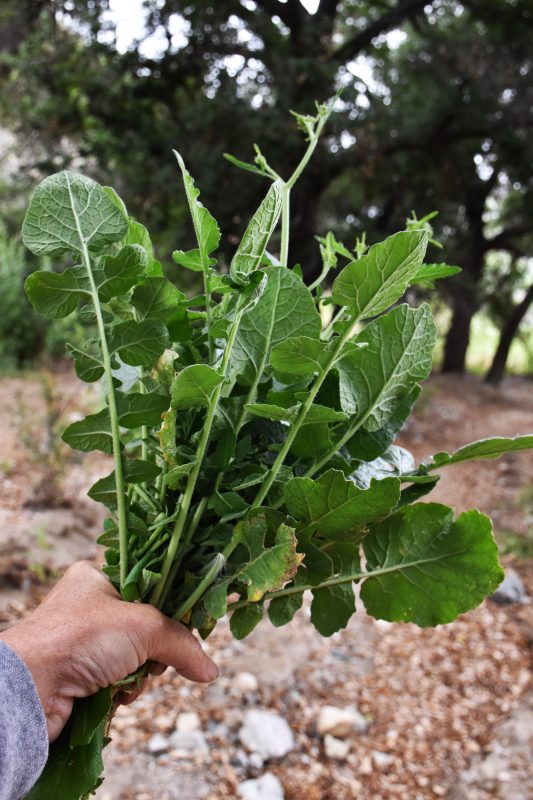As lines at Santa Clarita Valley grocery stores grow longer, naturalist Pascal Baudar is spending his time in the fresh air of the Angeles National Forest, foraging for wild plants.
“I don’t have to go to the store, stand in line or wear a mask,” Baudar said, jokingly. “It’s perfect.”
In fact, the Belgian-American hasn’t been to the store in 10 days, as he’s gathered all he needs naturally.
“I’m basically doing self-isolation, but I do go hiking and pick up my food every day,” he added.

With the recent rains, Baudar was able to find three different kinds of mustard, wild radish, mushrooms, wild oats and more in an hour’s walk.
“That’s all the time it takes to collect stuff, and nobody was around,” he said. “Meanwhile, I was passing by Ralph’s and there was a line of 30 people — it’s so strange.”
During his time in self-quarantine, Baudar has barely had to dip into what he calls his “COVID-19 pantry,” except for a few slight additions to his meals, such as pasta or rice.
“My whole goal is to not touch my pantry,” he said.

While you’d assume much of the plants he forages are native, about 95% are actually very often invasive and non-native to this area, according to Baudar.
“In America, a lot of the ‘weeds’ that we find are actually crops in other countries — this is the thing that’s fascinating,” he said. “You look at the hills in May, they are completely yellow. That’s either Mediterranean mustard or black mustard, which is a crop in France still.”
Baudar considers these “weeds” super valuable, though many wouldn’t agree.
“In my perspective, the biggest food waste in Los Angeles is edible non-native wild food,” he added. “Their solution is to put pesticides on (the weeds) … Why don’t we make food part of the solution?”

Chef Anna Barringer agrees, though in her opinion, making food a solution doesn’t stop there.
“Eating naturally shouldn’t be a chore,” she said. “Especially in today’s environment, where nearly every fresh fruit, vegetable or herb in a grocery store has been dosed with some kind of pesticide.”
Barringer also believes in eating foraged food, but often supplements that with a garden of her own.
“I can find foraged food to enhance my store-bought meal or I can create my entire meal without help, which is certainly a refreshing feeling,” she added.
Both Barringer and Baudar have learned to look at these plants not just as food, but gourmet food even.
“You can create a whole cuisine around it,” Baudar said.

“You’d never guess by looking at it, but these ingredients are actually becoming pretty trendy in the gourmet food industry,” Barringer added.
While much of the knowledge surrounding foraging for food has been forgotten, these plants remain everywhere.
“Many shy away from foraging because they don’t know how to cook it, but we live in an era where everything is Google-able and YouTube can teach you pretty much anything, so that’s no excuse anymore,” Barringer said. “And, what better time to start than during a pandemic?”
But, before jumping into the outdoor salad bowl, it’s critical to do your research. Read some guidebooks and start studying, learn which dangerous species to avoid, or find a mentor who can show you the ropes.
“Before eating any wild plant, you’ve got to make sure it isn’t poisonous,” Barringer said. “Only eat what you are 100% certain you can identify. Starting with common weeds is an easy way to get on the right track.”

Dandelions, wild onion, chickweed, violets and mustard are all likely growing in your very own yard.
Barringer suggests trying to challenge yourself to learn a new plant each forage. “The more you go, the more comfortable you’ll be and the better you’ll get.”
Though they’ve grown their own vegetables for years, Castaic couple Paula and Howard Briggs have recently started foraging themselves.
“We’ve always been outdoorsy people and love growing our own food, but never really realized we could also be foraging for it until just a few weeks ago,” Paula Briggs said, “when we met a vendor at the farmer’s market with some delicious foraged foods.”
Since then, that forager has taught the couple the basics, including what to look for in the SCV.
“I can’t wait for the time,” she said, “where we’ll be able to make an entire meal without having to have purchased one item.”












